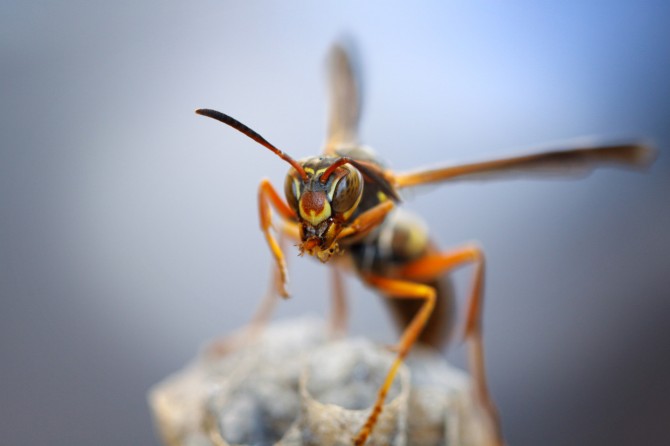Individuals within a species may all look alike to the average insect, but one paper wasp species has evolved specialized cognitive abilities to recognize individual faces among their peers. How did complex cognition evolve in just this species?
New research indicates facial recognition abilities evolved relatively rapidly – in the last few thousand years – suggesting that the wasps’ increasing intelligence provided an incredible evolutionary advantage. This new research also sheds light on how intelligence evolves in general, which has implications for many other species – including humans.
A team led by Cornell researchers used population genomics to study the evolution of cognition in the Northern paper wasp (Polistes fuscatus). The resulting paper, “Evolutionary dynamics of recent selection on cognitive abilities,” published Jan. 24 in Proceedings of the National Academy of Sciences.
“The big question we want to explore is how complex traits evolve. What is the mode and tempo of cognitive evolution?” said Michael Sheehan, the Nancy and Peter Meinig Family Investigator in the Life Sciences, and assistant professor in the Department of Neurobiology and Behavior. “The really surprising conclusion here is that the most intense selection pressures in the recent history of these wasps has not been dealing with climate, catching food or parasites, but getting better at dealing with each other. That’s pretty profound.”
Many vertebrates can recognize individual faces, at least in some circumstances, but among insects, facial recognition is quite uncommon. In this new study, Sheehan and his colleagues explored how and when this ability evolved by analyzing patterns of genetic variation within species. “It’s kind of like 23andMe, but with paper wasps,” Sheehan said.
The few species of insects that can recognize faces share one trait: communal societies with multiple queens. In communal groups with a single queen, like honeybee colonies, the roles are clear and each individual knows its place. But paper wasps may have five or more queens in one nest, and facial recognition helps these queens’ negotiations with one another.
The queens form a hierarchy, with the dominant queen producing most of the offspring. Subordinate queens can stay and lay a few eggs or leave to build their own nests. But smaller nests are more likely to be attacked, get stolen or die off.
“If you’re a subordinate in the group, you’re giving up a lot of chance to lay eggs. There are benefits to working in a group, but also costs to the individual,” Sheehan said. “In these societies where multiple queens are interacting with one another, that’s where recognition becomes so useful.”
In their battle for dominance, queens fight with one another. By recognizing each other’s faces, the queens can keep track of who they’ve already beaten, or been beaten by, which lessens aggression in the nest.
To study the evolutionary history of the wasps, Sheehan and his colleagues assembled genomes for Polistes fuscatus and two of its closest relatives. When they looked at the genetic variation across the wasps’ genomes, they were searching for DNA signatures that showed patterns of recent positive selection. When positive selection is strong and recent, it leaves a distinct mark, appearing as a long stretch of DNA with little variation among individuals in the population.
“We were looking for sections of DNA that lack diversity,” Sheehan said. “That suggests there are times when a new mutation appears that’s so beneficial, it sweeps the population. The longer the stretch of DNA lacking diversity, the more recent and intense selection would have to be.”
The analysis revealed that the strongest signatures of selection were by genes involved in insect vision, learning and memory – all traits involved in facial recognition.
To contextualize their findings, the researchers performed the same analyses on two closely related paper wasp species that don’t recognize faces. Those species did not show strong patterns of selection on learning or memory, bolstering the conclusion that individual recognition, a trait unique to P. fuscatus, has been responsible for the distinctive pattern of selection.
And while this research focused on paper wasps, the primary question Sheehan and his colleagues wanted to answer was how intelligence evolves in general.
“Our findings indicated that cognitive evolution is not necessarily incremental,” Sheehan said. “There are mutations happening that can cause big shifts. This suggests the possibility that rapid adaptation of cognitive ability could have been important in other species as well, like language in humans.”
Lead author Sara Miller is a postdoctoral fellow in the Sheehan Lab. Co-authors included doctoral student Andrew Legan and research associate Floria M.K. Uy, both of the Sheehan Lab. The research was conducted in collaboration with colleagues at Grand Valley State University, Duke University and the University of Miami.
The research was supported by grants from the National Institutes of Health New Innovator Award, a National Science Foundation Career Award to Sheehan and an NSF Postdoctoral Fellowship to Miller.
Krisy Gashler is a freelance writer for the College of Agriculture and Life Sciences.



